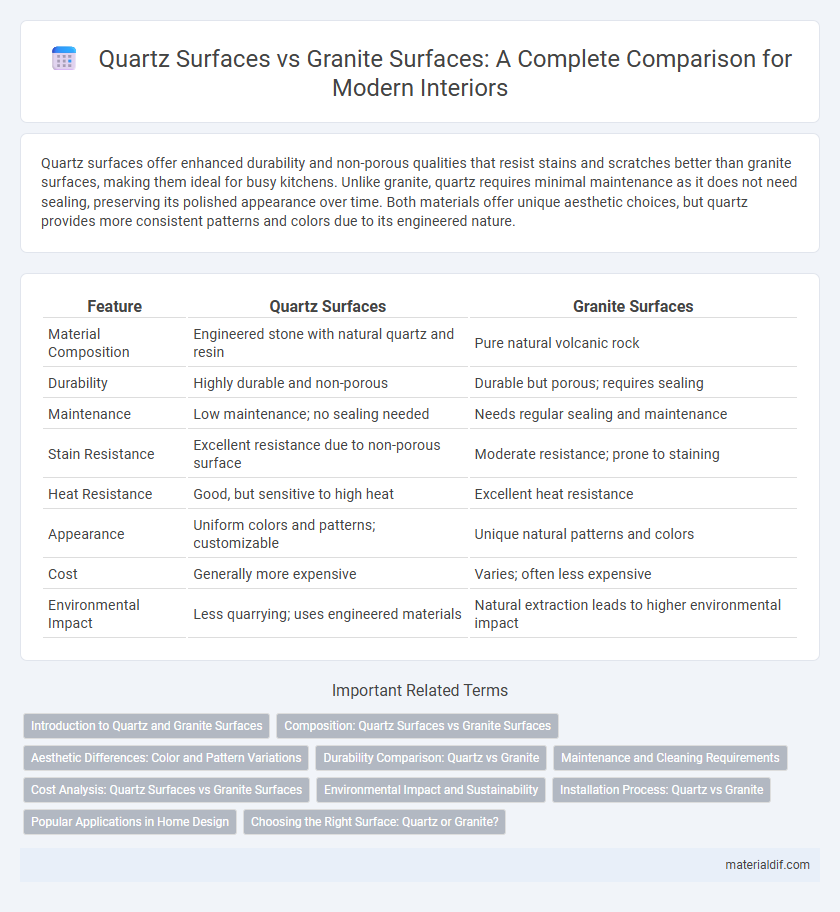Quartz surfaces offer enhanced durability and non-porous qualities that resist stains and scratches better than granite surfaces, making them ideal for busy kitchens. Unlike granite, quartz requires minimal maintenance as it does not need sealing, preserving its polished appearance over time. Both materials offer unique aesthetic choices, but quartz provides more consistent patterns and colors due to its engineered nature.
Table of Comparison
| Feature | Quartz Surfaces | Granite Surfaces |
|---|---|---|
| Material Composition | Engineered stone with natural quartz and resin | Pure natural volcanic rock |
| Durability | Highly durable and non-porous | Durable but porous; requires sealing |
| Maintenance | Low maintenance; no sealing needed | Needs regular sealing and maintenance |
| Stain Resistance | Excellent resistance due to non-porous surface | Moderate resistance; prone to staining |
| Heat Resistance | Good, but sensitive to high heat | Excellent heat resistance |
| Appearance | Uniform colors and patterns; customizable | Unique natural patterns and colors |
| Cost | Generally more expensive | Varies; often less expensive |
| Environmental Impact | Less quarrying; uses engineered materials | Natural extraction leads to higher environmental impact |
Introduction to Quartz and Granite Surfaces
Quartz surfaces are engineered stone products composed of approximately 90% natural quartz crystals combined with resin and pigments, offering durability, low porosity, and a wide range of colors and patterns. Granite surfaces are natural igneous rock slabs characterized by unique veining and mineral compositions, prized for their hardness, heat resistance, and natural aesthetic variations. Both materials are popular in countertops but differ in maintenance requirements, with quartz being non-porous and granite needing periodic sealing.
Composition: Quartz Surfaces vs Granite Surfaces
Quartz surfaces consist primarily of engineered quartz crystals bound with resin and pigments, resulting in a uniform and non-porous material that offers enhanced durability and stain resistance. In contrast, granite surfaces are natural stone formations composed mainly of quartz, feldspar, and mica, featuring unique mineral patterns and inherent porosity that requires regular sealing to maintain longevity and prevent staining. The engineered nature of quartz surfaces allows for consistent color and texture, while granite's natural variation provides distinct aesthetic appeal and organic character.
Aesthetic Differences: Color and Pattern Variations
Quartz surfaces offer a consistent and uniform appearance with a wide range of vibrant colors and patterns created through an engineered manufacturing process, allowing for precise customization. Granite surfaces, formed naturally, exhibit unique and varied patterns with intricate veining and a diverse palette of earth tones, providing a one-of-a-kind aesthetic for each slab. The inherent variability in granite contrasts with the controlled design of quartz, influencing choice based on desired visual impact and design consistency.
Durability Comparison: Quartz vs Granite
Quartz surfaces offer superior durability compared to granite due to their engineered composition, which makes them highly resistant to scratches, stains, and chips. Granite, being a natural stone, is more porous and prone to cracks and requires regular sealing to maintain its resilience. Quartz's non-porous nature ensures better resistance to bacteria and moisture, enhancing its longevity in both kitchen and bathroom applications.
Maintenance and Cleaning Requirements
Quartz surfaces require minimal maintenance, as they are non-porous and resist staining, eliminating the need for sealing. Granite surfaces demand periodic sealing to prevent stains and bacterial growth due to their porous nature. Cleaning quartz only necessitates mild soap and water, while granite may require specialized cleaners to maintain its seal and appearance.
Cost Analysis: Quartz Surfaces vs Granite Surfaces
Quartz surfaces typically cost between $50 to $150 per square foot, including installation, while granite surfaces range from $40 to $200 per square foot depending on grade and source. Quartz offers a more consistent price with lower maintenance costs due to its non-porous nature, whereas granite's price fluctuates with rarity and requires periodic sealing. Choosing quartz can result in long-term savings despite a higher initial investment, especially in high-traffic areas.
Environmental Impact and Sustainability
Quartz surfaces are engineered from natural quartz combined with resin, resulting in less mining waste and lower energy consumption compared to granite, which is quarried in large blocks and requires intensive extraction processes. The manufacturing of quartz slabs often incorporates recycled materials, enhancing sustainability efforts, while granite's environmental impact includes habitat disruption and high carbon emissions during transportation due to its weight. Quartz surfaces boast greater durability and resistance to wear, extending product lifespan and reducing the frequency of replacement, which contributes positively to environmental conservation.
Installation Process: Quartz vs Granite
Quartz surfaces involve a more streamlined and consistent installation process due to their engineered composition, allowing for easier cutting and shaping with standard tools. Granite surfaces require specialized skills for installation because the natural stone's irregularities and hardness demand precise handling and heavy-duty equipment. The uniformity of quartz often reduces installation time and minimizes the risk of damage compared to the more labor-intensive process of granite fitting.
Popular Applications in Home Design
Quartz surfaces dominate kitchen countertops and bathroom vanities due to their non-porous nature, providing superior stain resistance and low maintenance compared to granite. Granite surfaces, prized for their natural stone aesthetics and heat resistance, are frequently chosen for fireplace surrounds and outdoor kitchens. Both materials remain popular in home design, with quartz favored for modern, sleek interiors and granite preferred in classic or rustic settings.
Choosing the Right Surface: Quartz or Granite?
Quartz surfaces offer non-porous durability and low maintenance, making them resistant to stains and bacteria, ideal for busy kitchens. Granite surfaces provide natural stone aesthetics with unique patterns and heat resistance but require periodic sealing to prevent staining. Choosing quartz or granite depends on prioritizing ease of care versus authentic natural texture and heat tolerance.
Quartz Surfaces vs Granite Surfaces Infographic

 materialdif.com
materialdif.com